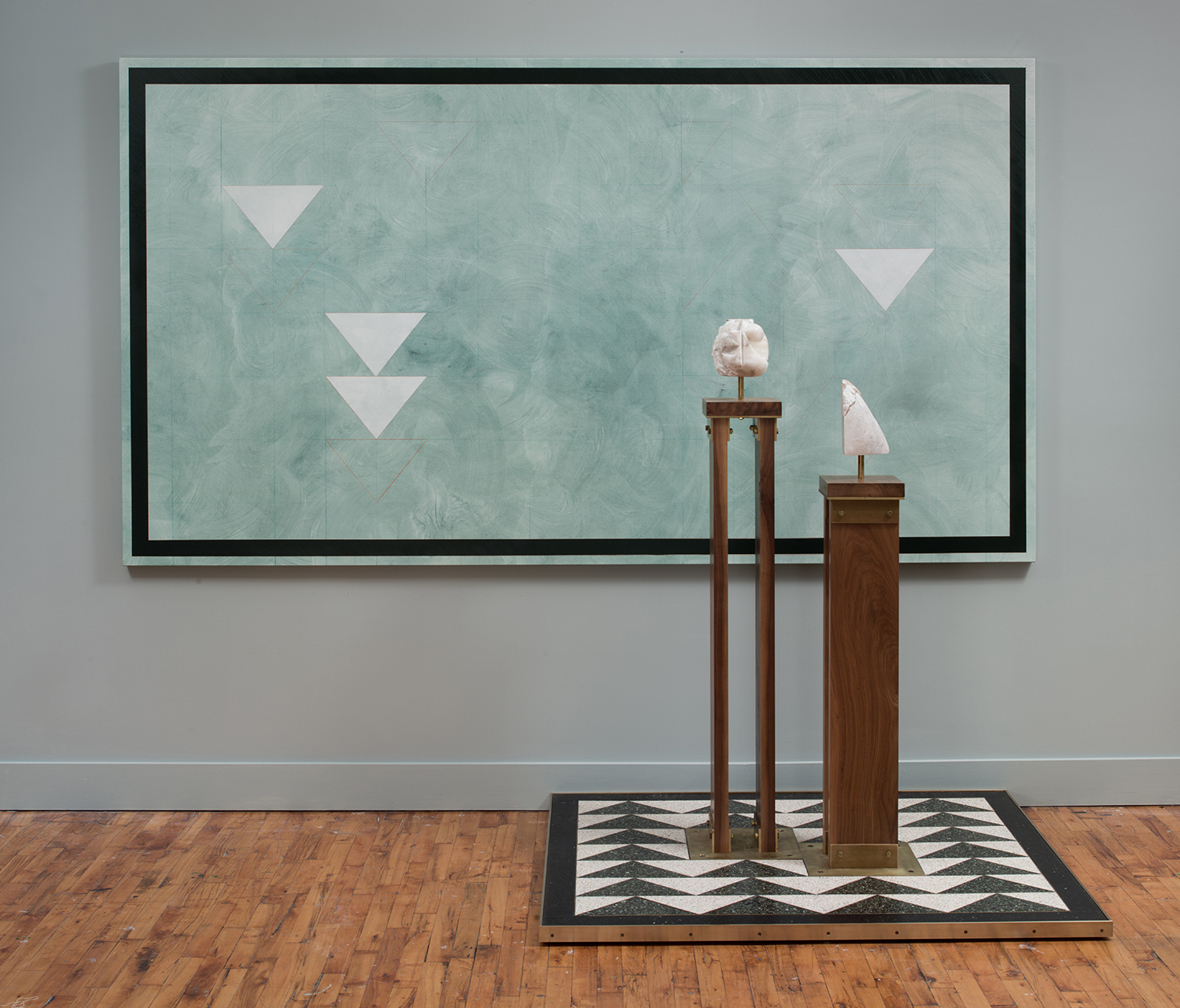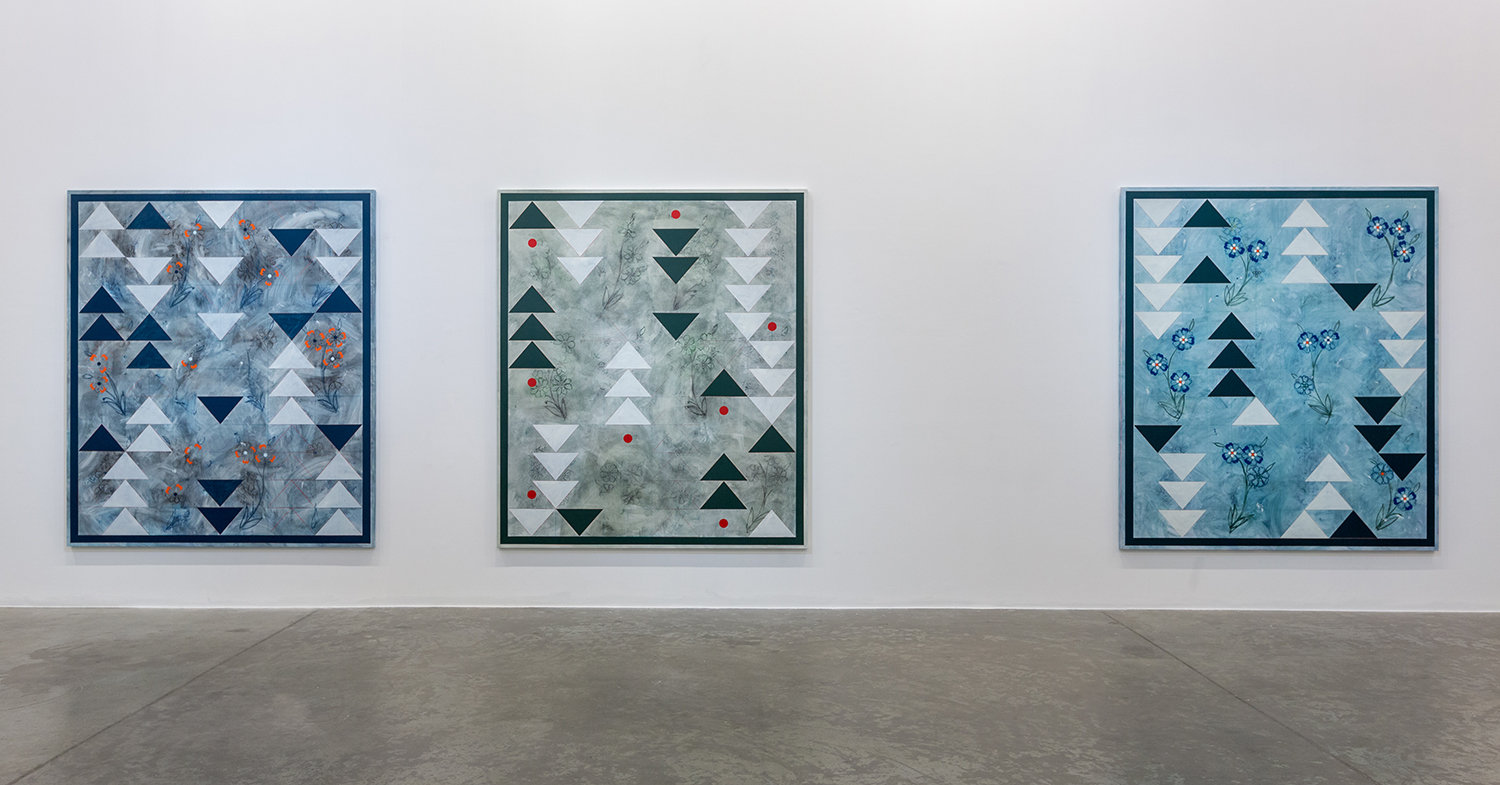Kamrooz Aram’s “Recollections for a Room”
By Suzy Sikorski

Installation view of KAMROOZ ARAM’s Ornament for a Quiet Room (2016) for the exhibition "Recollections for a Room" at Green Art Gallery, Dubai, 2016. Courtesy the artist and Green Art Gallery.
Kamrooz Aram, the Iranian-born, Brooklyn-based artist and 2014 Abraaj Group Art Prize recipient is back in Dubai with his second solo show at Green Art Gallery. Aram creates a site-specific installation that encompasses his passion for exhibition design, focusing on how an exhibition space stirs emotional response. “Recollections for a Room” contains patterns and compositions that exist within a state of flux, challenging viewers to consider the impact of contemporary art history on the value of artwork, and the reinforcement of representational motifs across both East and West by this stagnant Western tradition. In this exhibition, Aram creates a space where ornamentation exists in an unstable setting, nudging viewers to weigh its repercussions as they trace its journey across the visual arts.
Since preparing for his exhibition commissioned by the Abraaj Group Art Prize, “Ancient Through Modern: A Collection of Uncertain Objects, Part 1” (2014), Aram has focused on the presentation of objects in a mid-century exhibition catalogue titled 7000 Years of Iranian Art (1964) published by the Smithsonian Institution. He paid careful attention to the way these objects were photographed before bright blue or red backdrops; in other cases, they appeared in dramatically lit black and white photographs. These images inspired him to envision the museum as a site for cultural nostalgia, serving as a site for Iranians to commemorate their glorious history. Aram’s works address a failure to live in the present—some dwell in the past, defining themselves via borrowed grandeur of another age. This is accomplished by appropriating pictorial motifs that signify specific eras; Aram acknowledges these elements as a flawed representation that stagnates artistic evolution.

KAMROOZ ARAM, A Monument for Living in Defeat, 2016, canvas: oil, wax and pencil on canvas, 152.4 × 274.3 cm; tile platform: terrazzo and brass on panel, 137.2 × 122 × 5 cm; pedestals: solid walnut and brass pedestals, 122 × 20.3 × 20.3, 104 × 20.3 × 20.3 cm; sculptures: soapstone and alabaster, 17.8 × 16.5 × 15.2, 20.3 × 10.2 × 15.2 cm. Courtesy the artist and Green Art Gallery, Dubai.
Most striking is A Monument for Living in Defeat (2016), involving over a year’s preparation that combines painting techniques used to create the artist’s “Palimpsest” series (2013) with new sculptural processes. Two unidentified soapstone and alabaster sculptures sit on top of wooden pedestals of different sizes, resting on a tile terrazzo platform. Aram’s geometric shapes are found across the installation; black triangles unfold onto the painting and floorboards, representing a synergy between Eastern aesthetics and Western modernism’s repeated patterns. Without context, the historical references within this work are inhumed, and viewers are ultimately forced to see its many components as standing independently from each other. Investigating the temporality of these elements, from the floorboards to the found objects, viewers focus on the surfaces and quality of the material, trying to find these clues. Ultimately, this investigation is meant to provoke social interaction, drawing the audience’s visceral responses to the geometrical shapes.

KAMROOZ ARAM, Ornamental Composition for Social Spaces (2), 2016, oil, wax and pencil on canvas, 213.4 × 182.8 cm. Courtesy the artist and Green Art Gallery, Dubai.
Existing apart from the sculptural installations, Aram’s paintings serve as a point of entry into mapping out coordinates of time and space by showcasing the entire process through continued erasure and redrawing. The “Ornamental Composition for Social Space” series (2016) expands on his earlier “Palimpsest” paintings, repeating an isolated detail from Persian carpets he photographed in New York City. He begins with a pencil grid, using this as a guide for floral forms he traces in oil crayons, and then wipes away the existing illustrations with solvent and rags. After excavating pre-existing patterns, he draws over the blurred remaining forms with new geometrical shapes and floral motifs, while exposing the pencil grids to the surface during the production process.

Installation view of KAMROOZ ARAM’s exhibition
“Recollections for a Room” alters our sensitivity to a space by fine-tuning our ability to make sense of our surroundings through social interaction and methodical reasoning. Seeing the exhibition without wall text or artwork labels, viewers must grapple with the artworks' compositions without traditional art analysis, and instead memorialize the exhibition through a new visceral language of their own.
Kamrooz Aram’s “Recollections for a Room” was on view at Green Art Gallery, Dubai, until January 8, 2017.








